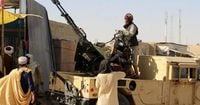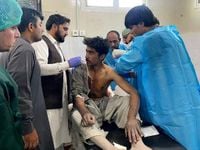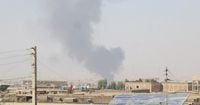After days of the deadliest border clashes in years, Pakistan and Afghanistan have agreed to a 48-hour ceasefire, offering a fragile pause in a conflict that has left dozens dead, hundreds wounded, and countless families fleeing their homes. The truce, which came into effect at 6pm local time (13:00 GMT) on October 15, 2025, follows appeals from major regional powers and urgent calls for de-escalation from the international community, including China, Russia, and even former U.S. President Donald Trump, who suggested he could help broker peace.
According to Associated Press, the ceasefire was described by Pakistan’s Foreign Ministry as being at Afghanistan’s request. However, the Taliban government’s chief spokesman, Zabihullah Mujahid, stated in a social media post that the truce was at the “insistence” of the Pakistani side, notably omitting mention of the 48-hour timeframe. This subtle difference in public messaging underscores the deep mistrust and competing narratives that have long characterized relations between the two neighbors.
The violence that prompted the ceasefire was both intense and widespread. Overnight on October 14-15, fighting erupted along the border, particularly in Afghanistan’s Spin Boldak district and Pakistan’s Chaman district. Each side accused the other of initiating the hostilities. Mujahid claimed that Pakistani forces fired “light and heavy weapons” at Afghanistan, killing 12 civilians and injuring more than 100, while a local spokesperson in Spin Boldak put the civilian death toll at 15. The AFP news agency cited a district hospital official who reported that 80 women and children were among the wounded.
Pakistan’s military, meanwhile, said it had “effectively repulsed” attacks from the Afghan Taliban, killing between 15 and 20 militants and injuring others. The military also reported repelling separate attacks in the Kurram District further north. “The insinuations that the attack was initiated by Pakistan, are outrageous and blatant lies, just like the claims of capturing Pakistani posts or equipment,” the military stated. “The Armed Forces stand resolute and fully prepared to defend the sovereignty and territorial integrity of Pakistan.” (Al Jazeera)
According to BBC News, none of the deaths reported by either side could be independently confirmed, but the humanitarian toll was clear. In Kabul, the Italian NGO EMERGENCY, which runs a surgical center, reported receiving 40 wounded and five dead following explosions in the capital. “We started receiving ambulances filled with wounded people, and we learned that there had been explosions a few kilometres away from our hospital,” said Dejan Panic, EMERGENCY’s country director in Afghanistan. “Forty people have arrived so far, including women and children. Unfortunately, five people were already dead on arrival.”
The Taliban confirmed an oil tanker explosion in Kabul, while Pakistani security officials said their army had targeted militant hideouts. Yet, the Taliban spokesman did not directly link the Kabul explosions to the border fighting, and Pakistani state media reported air strikes on targets in Kandahar province and Kabul. Taliban government sources told the BBC that Kabul had been hit by two air strikes, with plumes of black smoke rising above the capital and authorities sealing off some streets.
Locals on both sides of the border described a night of terror. In Spin Boldak, a resident told the BBC that “very heavy clashes continued for almost five hours” starting around 4:00am. “I see drones and jets flying over us, some of our relatives are wounded,” they said. A doctor at a Spin Boldak hospital reported seeing “seven bodies and 36 injured brought to the hospital,” including men, women, and children. “The situation is tense and more casualties are being taken to hospital,” he added.
In the Pakistani border town of Chaman, mortars fell near villages, forcing many families to flee. “People who live close to the border are leaving the area,” said resident Najibullah Khan, who pleaded for an end to the fighting. “People are in a very difficult situation. Shells are falling in people’s homes.” Hundreds of families have reportedly been displaced since the clashes began.
The violence is the latest chapter in a long and bitter history along the Pakistan-Afghanistan border. Since 1979, when Pakistan became a frontline state in the U.S.-backed war against the Soviet Union in Afghanistan, the region has been plagued by conflict, militant activity, and shifting alliances. After the September 11 attacks, Pakistan’s tribal belt descended into chaos as the Afghan Taliban, al-Qaida, and other groups operated from both sides of the border, targeting NATO forces and Pakistani security personnel.
Today, Pakistan accuses the Taliban-led Afghan government of sheltering fighters from the Tehrik-i-Taliban Pakistan (TTP), a charge Kabul denies. The TTP, often described as the Pakistani Taliban, has carried out numerous deadly attacks in Pakistan. Amid the latest clashes, Afghan Foreign Minister Amir Khan Muttaqi visited India, Pakistan’s regional rival, a move Islamabad “took strong note of,” according to Al Jazeera. Muttaqi, during a news conference in India, addressed the fraught relations, stating, “There are certain groups in Pakistan that are trying to stir up unrest.”
Over the weekend preceding the ceasefire, fighting flared across multiple border regions, with both sides trading fire and claiming heavy casualties. The Taliban said it had killed 58 Pakistani soldiers in retaliation for what it called repeated violations of Afghan territory and airspace. Pakistan’s military reported lower figures, saying it lost 23 soldiers but killed more than 200 “Taliban and affiliated terrorists” in retaliatory fire. Videos purportedly showing the fighting and its aftermath circulated widely on social media, though the BBC could not verify their authenticity.
Calls for restraint have come from many quarters. Richard Bennett, UN special rapporteur on the situation of human rights in Afghanistan, wrote on X, “I urge all parties to exercise maximum restraint, protect civilians, and abide by international law.” Saudi Arabia and Qatar also appealed for calm, helping to bring about the current ceasefire.
Despite the truce, tensions remain high. Most border crossings are still closed, and both sides continue to trade accusations. The ceasefire agreement itself is a study in contrasts: each side claims credit for initiating it, and both maintain that they are acting in self-defense. Yet, as families flee, hospitals fill with the wounded, and international actors look on with concern, the human cost of the conflict is undeniable.
For now, the guns have fallen silent—at least temporarily. But as the region waits to see whether dialogue can deliver a lasting solution, the scars of the latest violence linger, and the prospect of renewed hostilities remains an ever-present threat.


